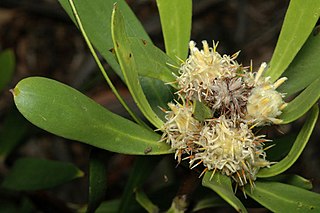
A sphere is a geometrical object in three-dimensional space that is the surface of a ball.
Globuloviridae is a family of hyperthermophilic archaeal viruses. Crenarchaea of the genera Pyrobaculum and Thermoproteus serve as natural hosts. There are currently only two species in this family, Pyrobaculum spherical virus and Thermoproteus tenax spherical virus 1, included into a single genus, Globulovirus. Two tentative members of the family, Pyrobaculum spherical virus 2 and Thermoproteus spherical piliferous virus 1 have been isolated but not officially classified.

Spumellaria is an order of radiolarians in the class Polycystinea.

Isopogon prostratus, commonly known as prostrate cone-bush, is a species of plant in the family Proteaceae and is endemic to south-eastern Australia. It is a prostrate shrub with divided leaves with linear lobes, and more or less spherical heads of yellow flowers on the ends of branchlets.

Isopogon asper is a species of plant in the family Proteaceae and is endemic to the south-west of Western Australia. It is a low shrub with crowded pinnate leaves and flattened spherical heads of glabrous pink flowers.

Isopogon attenuatus is a species of plant in the family Proteaceae and is endemic to the south-west of Western Australia. It is a shrub with oblong to spatula-shaped or linear leaves and spherical heads of yellow flowers.

Isopogon baxteri, commonly known as the Stirling Range coneflower, is a species of plant in the family Proteaceae and is endemic to the south-west of Western Australia. It is an erect shrub with wedge-shaped, often 3-lobed, toothed leaves and flattened spherical heads of hairy pink flowers.

Isopogon divergens, commonly known as spreading coneflower, is a species of plant in the family Proteaceae and is endemic to the south-west of Western Australia. It is a shrub with pinnate leaves and more or less spherical heads of glabrous pink flowers followed by an oval to cylindrical fruiting cone.

Isopogon petiolaris is a species of plant in the family Proteaceae and is endemic to eastern Australia. It is a low, spreading shrub with sharply-pointed, divided leaves and more or less spherical heads of yellow flowers.

Isopogon polycephalus, commonly known as clustered coneflower, is a species of plant in the family Proteaceae and is endemic to the south coast of Western Australia. It is a spreading shrub with linear to lance-shaped leaves with the narrower end towards the base, and clusters of more or less spherical heads of white, cream-coloured or yellow flowers.

Petrophile arcuata is a species of flowering plant in the family Proteaceae and is endemic to southwestern Western Australia. It is a spreading shrub with cylindrical leaves and oval to spherical heads of hairy yellowish flowers.

Petrophile brevifolia is a species of flowering plant in the family Proteaceae and is endemic to southwestern Western Australia. It is a shrub with cylindrical, sharply-pointed leaves, and spherical heads of hairy yellow, cream-coloured or white flowers.
Petrophile latericola is a species of flowering plant in the family Proteaceae and is endemic to southwestern Western Australia. It is an erect shrub with needle-shaped leaves and spherical heads of bright yellow flowers.

Petrophile merrallii is a species of flowering plant in the family Proteaceae and is endemic to southwestern Western Australia. It is an erect shrub with spreading, needle-shaped leaves and oval to spherical heads of hairy yellow flowers.

Petrophile misturata is a species of flowering plant in the family Proteaceae and is endemic to southwestern Western Australia. It is a shrub with simple and pinnate, needle-shaped leaves and spherical heads of hairy, dull yellow flowers.

Petrophile pauciflora is a species of flowering plant in the family Proteaceae and is endemic to western areas of Western Australia. It is a shrub usually with three-forked leaves, the lobes sharply-pointed, and spherical heads of small groups of hairy yellow or orange flowers.

Petrophile teretifolia is a species of flowering plant in the family Proteaceae and is endemic to southwestern Western Australia. It is a shrub with needle-shaped but blunt-pointed leaves, and oval to more or less spherical heads of hairy pink to mauve flowers.

Petrophile wonganensis is a species of flowering plant in the family Proteaceae and is endemic to south-western Western Australia. It is a dense shrub with blunt, needle-shaped leaves, and more or less spherical heads of hairy, yellow flowers.

Isopogon crithmifolius is a species of plant in the family Proteaceae and is endemic to the south-west of Western Australia. It is a shrub with divided leaves and more or less spherical heads of glabrous reddish pink flowers.
Actinommidae is a family of radiolarians.



















